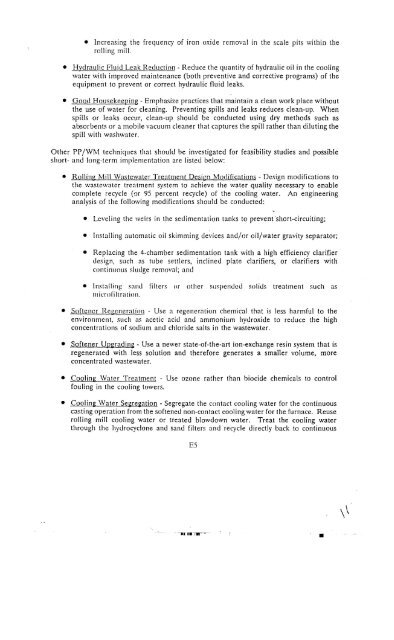Watcr Q!!alit\1 lmprovcmct1t at1() COf1scrvatiof1l'rojcct
Watcr Q!!alit\1 lmprovcmct1t at1() COf1scrvatiof1l'rojcct
Watcr Q!!alit\1 lmprovcmct1t at1() COf1scrvatiof1l'rojcct
You also want an ePaper? Increase the reach of your titles
YUMPU automatically turns print PDFs into web optimized ePapers that Google loves.
• Increasing the frequency of iron oxide rcmoval in the scale pits within the<br />
rolling mill.<br />
• Hydraulic Fluid Leak Reduction - Reduce the quantity of hydraulic oil in the cooling<br />
water with improved maintenance (both preventive and corrective programs) of the<br />
equipment to prevent or correct hydraulic fluid leaks.<br />
• Good Housekeeping - Emphasize practices that maintain a clean work place without<br />
the use of water for cleaning. Preventing spills and leaks reduces clean-up. When<br />
spills or leaks occur, clean-up should be conducted using dry methods such as<br />
absorbents or a mobile vacuum cleaner that captures the spill rather than diluting the<br />
spill with washwater.<br />
Other PP/WM techniques that should be investigated for feasibility studies and possible<br />
short- and long-term implementation are listed below:<br />
• Rolling Mill Wastcwatcr Tre;1tmen( Dcsi(;n Modifications - Dc.c;ign modifications to<br />
the wastewater treatment system to achieve the water quality necessary to enable<br />
complete recycle (ar 95 percent recycle) of the cooling water. An engineering<br />
analysis of the following modifications should be conducted:<br />
• Leveling the weirs in the sedimentation tanks to prevent 'short-circuiting;<br />
• Installing automatic oil skimming devices and/or oil/water gravity separator;<br />
• Replacing the 4-chamber sedimentation tank with a high efficiency clarifier<br />
design, such as tube settlers, inclined plate clarifiers, or clarifiers with<br />
continuous sludge removal; and<br />
• Installing sand filtcrs or other sllspentlco solitls treatment such as<br />
J11 iemfi Itrati on.<br />
• Softcncr Rcgcneration - Use a regencration chemical that is less harmful to the<br />
environmcnt, sllch as acetic acid ano ammonium hyoroxide to reduce the high<br />
concentrations of sotlium and chloride salts in the wastewater.<br />
• Softener Upgrading - Use a newer state-of-the-art ion-exchange resin system that is<br />
regenerated with less solution and therefore generates a smaller volume, more<br />
concentrated wastewater.<br />
• Cooling Water Treatment - Use ozone rather than biocide chemicals to control<br />
fouling in the cooling towers.<br />
• Cooling Water Segregation - Segregate the contact cooling water for the continuous<br />
casting operation from the softened non-contact cooling water for the furnace. Reuse<br />
rolling mill cooling water or treated blowdown water. Treat the cooling water<br />
through the hydrocyclone and sand filters and recycle directly back to continuous<br />
E5<br />
•

















